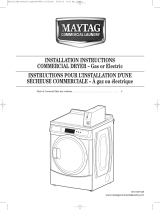
7
Flexible metal appliance connector
■ It is recommended that a new flexible stainless steel gas line,
design-certified by CSA International, be used for connecting
the dryer to the gas supply line. (The gas pipe which extends
through the lower rear of the dryer is provided with
3
⁄8" male
pipe thread.)
■ Do not kink or damage the flexible stainless steel gas line
when moving the dryer.
Rigid pipe connection
The rigid pipe connection requires a combination of pipe fittings
to obtain an in-line connection to the dryer.
■ Must include a shutoff valve:
The supply line must be equipped with a manual shutoff
valve. In the U.S., the valve must be installed within 6 ft. (1.8
m) of dryer in accordance
with National Fuel Gas
Code, ANSI Z223.1. In
Canada, an individual
manual shutoff valve must
be installed in accordance
with the B149 installation
codes CAN/CGA B149.1
and CAN/CGA B149.2.
This valve should be
located in the same room
as the dryer. It should be in
a location that allows ease of opening and closing. Do not
block access to shutoff valve. The valve is for turning on or
shutting off gas to the dryer.
■ Installed in a confined area:
If the dryer is installed in a confined area such as a bathroom,
provision must be made for enough air for combustion and
ventilation. Check governing codes and ordinances or refer to
the “Recessed Area Installation Instructions” in the “Location
Requirements” section.
Gas Supply Requirements
IMPORTANT: Observe all governing codes and ordinances.
This installation must conform with all local codes and
ordinances. In the absence of local codes, installation must
conform with American National Standard, National Fuel Gas
Code ANSI Z223.1/NFPA 54.
A copy of the above code standards can be obtained from:
National Fire Protection Association
One Batterymarch Park, Quincy, MA 02269
The design of this dryer has been certified by CSA International
for use at altitudes up to 10,000 feet (3048 m) above sea level at
the B.T.U. rating indicated on the model/serial plate. Burner input
adjustments are not required when the dryer is operated up to
this elevation.
When installed above 10,000 feet (3048 m), a four percent (4%)
reduction of the burner B.T.U. rating shown on the model/serial
plate is required for each 1,000 foot (305 m) increase in elevation.
For assistance when converting to other gas types and/or
installing above 10,000 feet (3048 m) elevation, contact your
local service company.
Type of Gas
This dryer is equipped for use with natural gas. It is design-
certified by CSA International for L.P. (propane and butane) gases
with appropriate conversion. No attempt shall be made to convert
the dryer from the gas specified on the serial/rating plate for use
with a different gas without consulting the serving gas supplier.
Conversion must be done by a qualified service technician.
Gas conversion kit part numbers are listed on the gas valve
burner base.
WARNING
Explosion Hazard
Use a new CSA International approved gas supply line.
Install a shut-off valve.
S
ecurely tighten all gas connections.
If connected to LP, have a qualified person make sure
gas pressure does not exceed 13" (33 cm) water
column.
Examples of a qualified person include:
licensed heating personnel,
authorized gas company personnel, and
authorized service personnel.
Failure to do so can result in death, explosion, or fire.
Gas Supply Line
Recommended method
■ Provide a gas supply line of
1
⁄2" rigid (IPS) pipe to the dryer
location. Pipe joint compounds that resist the action of LP gas
must be used. Do not use TEFLON
®†
tape. With LP gas,
piping or tubing size can be
1
⁄2" minimum. Usually, LP gas
suppliers determine the size and materials used in the system.
Alternate method
■ The gas supply may also be connected using
3
⁄8" approved
copper or aluminum tubing. If the total length of the supply
l
ine is more than 20 feet (6.1 m), larger tubing will be required.
If using natural gas, do not use copper tubing. Pipe joint
compounds that resist the action of LP gas must be used.
†®TEFLON is a registered trademark of E.I. Du Pont De Nemours and Company.
A. Gas supply line
B. Shutoff valve in “open” position
C. To dryer
D. NPT 1/8” min. plugged tapping





















